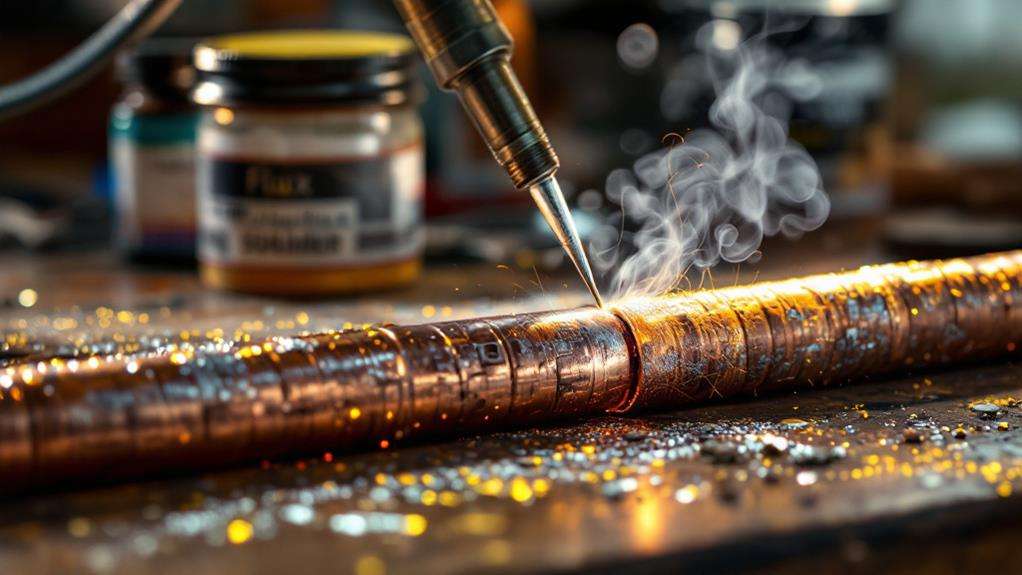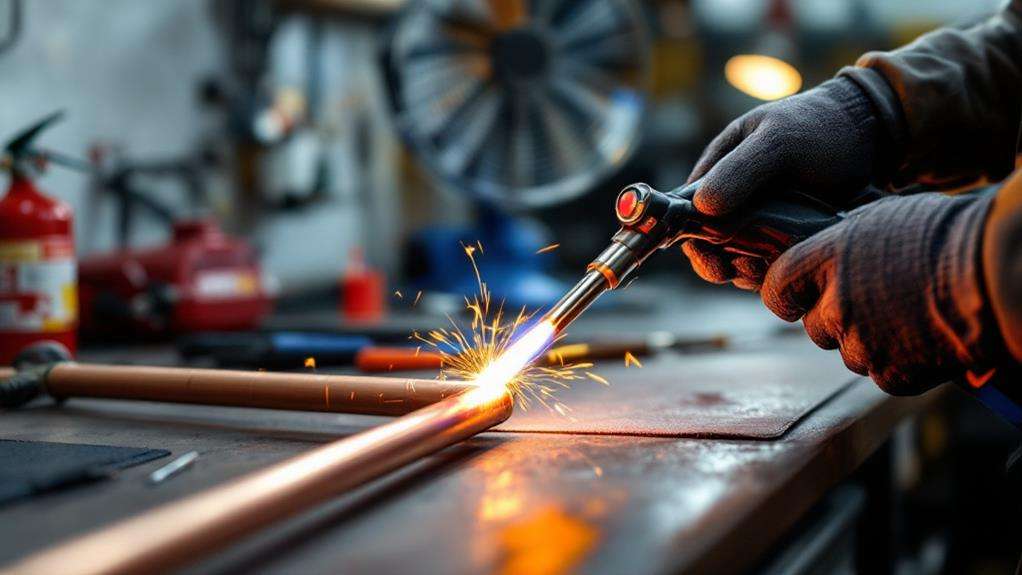Best Soldering Tools for Plumbing: Tips and Tools
To excel at plumbing soldering, you'll need the right tools and techniques. Start with a reliable heat source like a propane or MAPP gas torch, lead-free solder, and appropriate flux. Essential tools include surface preparation items like wire brushes and emery cloth. Choose a torch with a rose bud-shaped flame for effective joint wrapping. Select solder and flux that meet safety standards for potable water systems. Properly clean and prepare surfaces, apply flux sparingly, and maintain a tight fit between pipe and fitting. Don't forget safety gear like glasses and gloves. These basics will set you on the path to becoming an expert in the art of plumbing soldering.
Essential Soldering Tools
When it comes to soldering plumbing, you'll need a well-equipped toolkit to guarantee success. Let's plunge into the essential soldering tools you'll want to have on hand for your plumbing projects.
First and foremost, you'll need a reliable heat source. Propane torches are a popular choice, but you might also consider MAPP gas or butane torches depending on your specific needs. Next, choose the right solder for your job. Lead-free solder is increasingly common, but 50/50 and 60/40 solder compositions are also options for certain applications.
Flux is indispensable for ensuring proper solder flow and adhesion. You'll find paste, liquid, and rosin flux varieties, each with its own advantages. Don't forget about surface preparation tools like brass wire brushes, stainless steel brushes, or flux brushes to clean your copper pipes before soldering.
Other essential items include emery cloth for fine cleaning, flux remover for post-soldering cleanup, and deburring tools to smooth cut pipe edges. A tubing cutter will help you achieve clean, straight cuts, while a soldering mat protects your work surface from heat damage. With these tools at your disposal, you'll be well-prepared to tackle your plumbing soldering tasks.
Choosing the Right Torch
Three key factors come into play when choosing the right torch for plumbing soldering: flame shape, heat intensity, and fuel type. When it comes to flame shape, you'll want to look for a rose bud-shaped flame, which is ideal for soldering copper pipes. TurboTorch by Thermodyne is recommended for its ability to effectively wrap around plumbing joints. Avoid common household propane torches with cone-shaped flames, as they're not suitable for this task.
Heat intensity is paramount for efficient soldering. MAPP gas, a combination of propane and acetylene, provides a hotter flame than liquid propane. This allows for faster work but requires more caution to avoid scorching the flux. When using MAPP gas, keep your work in the blue part of the rose bud flame and steer clear of the pale blue at the flame's root.
Regarding fuel type, consider the trade-offs between propane and MAPP gas. While MAPP gas offers higher heat, it also comes with a higher risk of scorching. Whichever fuel you choose, remember to angle the flame at about 45 degrees to the joint and use only the necessary size to avoid damage to your potable water system.
Solder and Flux Selection

Now that you've selected the right torch, it's time to focus on choosing the appropriate solder and flux for your plumbing project. For potable water applications, it's essential to use lead-free solder with a rosin-based flux core. This guarantees the safety of your drinking water and complies with regulations.
When soldering pipes, select a solder diameter that matches the pipe size for optimal flow. Look for a solder with a melting range between 400-600°F to achieve strong, reliable solder joints. Additionally, you'll need a non-corrosive, water-soluble paste flux to facilitate the bonding process.
Apply the flux sparingly to the cleaned pipe and fitting surfaces. Using too much flux can lead to corrosion, so be cautious. Confirm a tight fit between the pipe and fitting before soldering. If necessary, disassemble the joint to clean and reassemble the surfaces before applying flux and solder.
Preparation and Technique
Proper preparation and technique are essential for successful soldering in plumbing projects. When soldering copper pipes, you'll need to focus on several key steps to guarantee a strong, leak-free joint.
First, thoroughly clean and prepare the pipe and fitting surfaces. This step is imperative for proper solder adhesion and getting the job done right. Once cleaned, apply flux sparingly to help the solder flow and adhere to the joint. Different types of soldering may require specific flux, so choose wisely.
Next, ensure a tight fit between the pipe and fitting. If necessary, disassemble and reassemble the joint for proper alignment. When you're ready to solder copper, adjust your torch flame to a neutral, blue-tipped appearance. Position the flame at a 45-degree angle to the joint for even heat distribution.
As you heat the joint, watch for the solder to begin melting. Apply the solder and move the flame around the joint to guarantee adequate solder flow and coverage. This technique will help you create a strong, reliable connection in your plumbing projects. Remember, practice makes perfect when it comes to soldering, so don't be discouraged if your first attempts aren't flawless.
Safety and Best Practices

While perfecting soldering techniques is important, prioritizing safety and following best practices is equally vital for successful plumbing projects. When working on drinking water systems, it is imperative to use solder for potable water and flux core materials that meet safety standards. Protect yourself and your work environment by:
- Wearing safety glasses and heat-resistant gloves
- Ensuring proper ventilation or using a fume extractor
- Keeping a fire extinguisher nearby
- Clearing the area of combustible materials
Handle hot soldering tools with extreme care, and always unplug them when not in use. Allow tools to cool completely before storing them to prevent accidental burns. Be aware of potential fume hazards, especially when working with lead-based solder, and take necessary precautions to protect your health.
Proper disposal of waste solder, flux, and other materials is indispensable for minimizing environmental impact and complying with local regulations. This practice also helps maintain a clean and safe Supply Chain for future plumbing projects.
